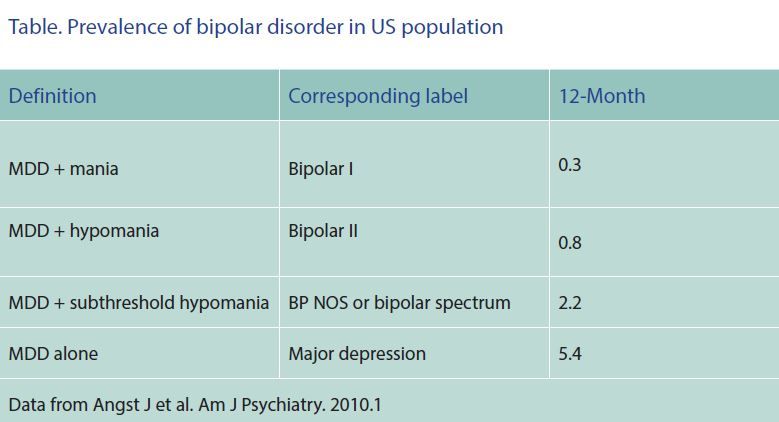Article
CrowdStudying Ourselves: Approaches to Bipolar Disorders
Author(s):
Do you think you have all the answers? For this quiz, you do.
Table. Prevalence of bipolar disorder in US population

What do practicing psychiatrists and psychiatric nurse practitioners (and soon, the growing number of prescribing psychologists) actually think? How do they make choices with patients? Not treatment guidelines, but real decisions by front-line providers?
You can help answer these questions. You’d probably like to see answers from your colleagues as well. So, please partake. This will be a series of 2- or 3-question queries with explanations and data for each. I’ll add a synthesis of the series when we have a large N.
Patients and families: welcome! Please select the “patients and families” option in each question to keep our data meaningful.
Bipolar Queries, Part 1: Prevalence
Question 1.
For the answer to Question 1, see the next page >>
Answer to Question 1: Rates from the National Comorbidity Survey Replication, the largest US epidemiological study, are listed in the Table.1
Granted, these are telephone interview data, so many grains of salt are warranted here. But the results provide a rough starting point, at least. As you can see, the 12-month prevalence of bipolar I disorder and bipolar II disorder among US adults is 1.1 %. But the prevalence is 3.3% if one counts subthreshold hypomania as “bipolar.”
The authors’ definition of subthreshold hypomania required a positive on one of the DSM A criteria except that length was defined as “several days or longer,” and no B criteria were required. This is, admittedly, a very broad definition of bipolarity.
But before you object, note their findings. Frequency of a positive family history of bipolar disorder was the same in the bipolar II and subthreshold groups. The subthreshold group had more episodes of depression than those with MDD alone, and (as in many studies of bipolar disorder per se) an earlier age of onset of mood disorder.
Whatever this subthreshold thing is, it differs from MDD alone. As the authors set out to demonstrate, it has “validity” as a separate kind of mood disorder, even though it does not meet DSM criteria for bipolar disorder.
So, the answer to the question of bipolar prevalence is “it depends”-on the definition you had in mind when answering the question.
For Question 2, see the next page >>
Question 2.
For the answer to Question 2, see the next page >>
Answer to Question 2. As in Question 1, “it depends” first on the definition you’re using and then on the kind of practice you have. Maybe your practice selects for patients who don’t have bipolar disorders, so your number might be 10% or even 5% (2% is nearing the population prevalence). On the other hand, if you take a lot of referrals from primary care (where unipolar depression may be “culled out”), the percentage could be very high. Indeed, in our primary care consultation program at Samaritan Mental Health in Corvallis, Oregon-where we’ve implemented a version of the Collaborative Care Model from the University of Washington-the prevalence of bipolarity is around 50% (unpublished data; most of the other 50% are trauma sequelae, including PTSD).
We use the Composite International Diagnostic Interview (CIDI) 3.0 from the World Health Organization, as does UW’s Collaborative Care program. But we add the Bipolarity Index, which I’ll detail in a subsequent essay. In this we are following an approach advocated by Gary Sachs, head of the STEP-BD research program, asking not “Does the patient have bipolar disorder?” but rather “How bipolar is this patient?” This broader view of bipolarity has been investigated in 2 large epidemiologic studies, as follows.
Related content:
CrowdStudying Ourselves: Approaches to Bipolar Disorders, Part 2
The National Comorbidity Survey Replication cited in Question 1 found that “nearly 40% of study participants with a history of MDD had a history of subthreshold hypomania.”1 Right: 40%. In other words, this subthreshold thing, which behaves like bipolar disorder in family history and increased number of episodes and earlier age of onset (relative to MDD alone), is highly prevalent among patients with depression.
Similarly, the BRIDGE study found that 47% of patients with depression met their “bipolarity specifier criteria.”2 This specifier attributes a diagnosis of bipolar disorder when 3 DSM B criteria are met, with no minimum duration, but at least 1 of 3 consequences: (1) unequivocal and observable change in functioning uncharacteristic of the person’s usual behavior, (2) marked impairment in social or occupational functioning observable by others, or (3) requiring hospitalization or outpatient treatment.
So, what is the prevalence of bipolar disorder among patients who present with depression in your practice? As you can see, the answer again depends highly on the definitions you are using-as well as the kind of practice you have. It will be interesting to see what percentages you’ve picked!
Disclosures:
Dr. Phelps is Director of the Mood Disorders Program at Samaritan Mental Health in Corvallis, Ore. He is the Bipolar Disorder Section Editor for Psychiatric Times. Dr. Phelps stopped accepting honoraria from pharmaceutical companies in 2008 but receives honoraria from McGraw-Hill and W.W. Norton & Co. for his books on bipolar disorders, including Bipolar, Not So Much, a book he coauthored with Chris Aiken, MD.
References:
1. Angst J, Cui L, Swendsen JJ, et al. Major depressive disorder with sub-threshold bipolarity in the National Comorbidity Survey Replication. Am J Psychiatry. 2010;167:1194-1201.
2. Angst J, Azorin JM, Bowden CL, et al; BRIDGE Study Group. Prevalence and characteristics of undiagnosed bipolar disorders in patients with a major depressive episode: the BRIDGE study. Arch Gen Psychiatry. 2011;68:791-798.






